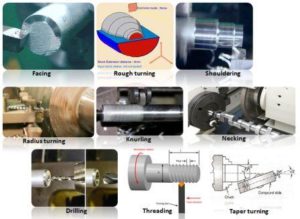OPERATIONS PERFORMED ON MILLING MACHINE
Unlike a lathe, a milling cutter does not give a continuous cut, but begins with a sliding motion between the cutter and the work. Then follows a crushing movement, and then a cutting operation by which the chip is removed. Many different kinds of operations can be performed on a milling machine but a few of the more common operations will now be explained. These are:
Plain milling or slab milling
Fig. illustrates the plain and slab milling operation. It is a method of producing a plain, flat, horizontal surface parallel to the axis of rotation of the cutter.
Face milling
Fig. illustrates the face milling operation. It is a method of producing a flat surface at right angles to the axis of the cutter.
Side milling
Fig. illustrates the side milling operation. It is the operation of production of a flat vertical surface on the side of a work-piece by using a side milling cutter.
Angular milling
Fig. illustrates angular milling operation. It is a method of producing a flat surface making an angle to the axis of the cutter.
Gang-milling
Fig. illustrates the gang milling operation. It is a method of milling by means of two or more cutters simultaneously having same or different diameters mounted on the arbor of the milling machine.
Form milling
Fig. illustrates the form milling operation. It is, a method of producing a surface having an irregular outline.
End milling
Fig. illustrates end milling operation. It is a method of milling slots, flat surfaces, and profiles by end mills.
Profile milling
Fig. illustrates profile milling operation. It is the operation of reproduction of an outline of a template or complex shape of a master die on a work piece.
Saw milling
Fig. illustrates saw milling operation. It is a method of producing deep slots and cutting materials into the required length by slitting saws.
T-slot milling
Fig. illustrates T-slot milling operation.
Keyway milling
Fig. illustrates keyway milling operation.
Gear cutting milling
Fig. illustrates gear cutting milling operation.
Helical milling
Fig. illustrates helical milling operation.
Flute milling
It is a method of grooving or cutting of flutes on drills, reamers, taps, etc.
Straddle milling
It is a method of milling two sides of a piece of work by employing two side-milling cutters at the same time.
Thread milling
It is a method of milling threads on dies, screws, worms, etc. both internally and externally. As an alternative to the screw cutting in a lathe, this method is being more extensively introduced now a day in modern machine shops.
Source Introduction of Basic Manufacturing Processes and Workshop Technology by Rajender Singh.













Post Comment
You must be logged in to post a comment.